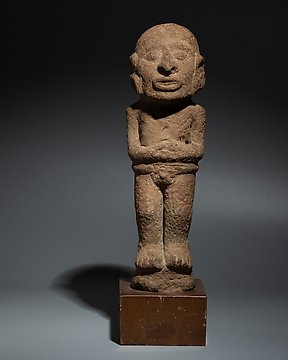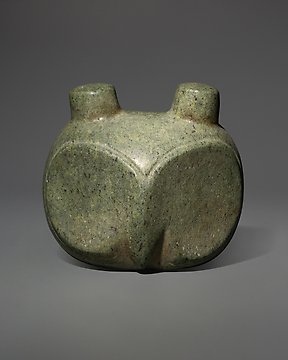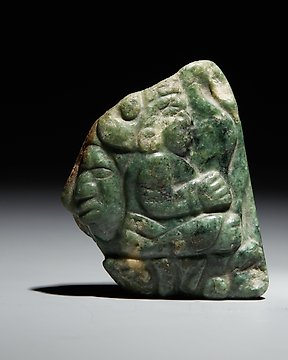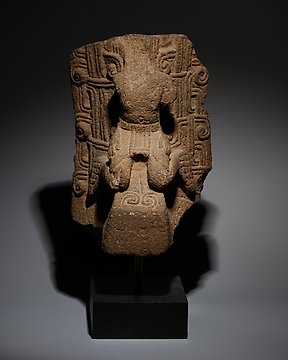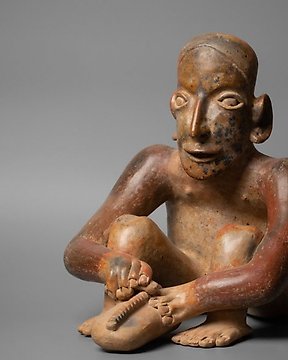Todo correcto. Gracias
Προβολή μετάφρασηςNicoya - Guanacaste, Κόστα Ρίκα. Νεφρίτης Ανθρωπομορφικό μενταγιόν, γ. 300 - 500 μ.Χ. 9 εκ. Ισπανική άδεια εξαγωγής.
Αρ. 85154527
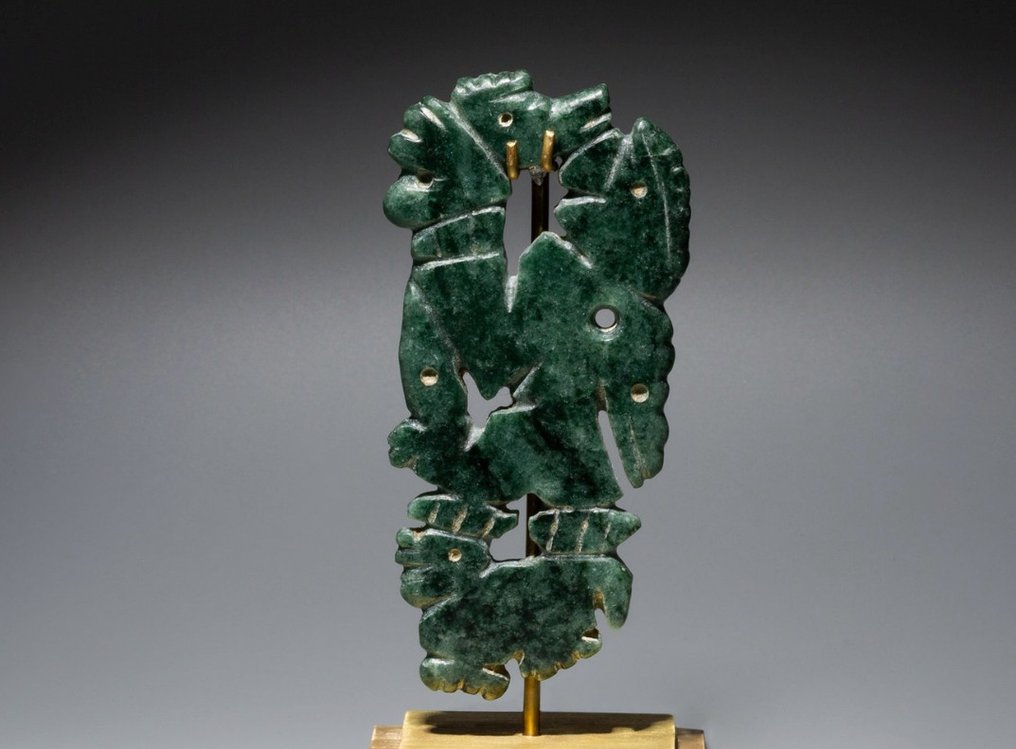





Anthropomorphic pendant.
- Important Piece! -
- Export License -
- Intact -
Nicoya - Guanacaste, Costa Rica. c. 300 - 500 AD.
Jade stone.
9 cm height,
PROVENANCE:
- Private collection, USA
- Banks - Primitive Inc., Maryland, USA, September 30, 1994.
- Private collection, Remy Rey, London, United Kingdom. Acquired from the previous one.
CONDITION: Intact.
BIBLIOGRAPHY:
- FERNÁNDEZ, P.; ALVARADO, G.E. Artisans and Stones: Pre-Columbian Tools and Sculpture in Costa Rica. Central Bank of Costa Rica Museums Foundation. 2006.
- FERRERO, L. Pre-Columbian Costa Rica: archeology, ethnology, technology, art. Costa Rica Publishing. 2000.
DESCRIPTION:
A pendant carved in jade (jadeite) depicting an anthropomorphic figure accompanied by two animals, with details on one side only. The design combines intricate outline carving with incised lines and small perforations. The figure is depicted with his body facing the front and his face in profile; his legs are wide apart, resting on the figure of an animal that is difficult to identify, possibly a quadruped. With his right hand, the figure holds the elongated body of a second beast, probably a snake, whose head rests on the nose of the priest, god or warrior chief who holds and dominates it. The small incised holes in the eyes of the man and the animals, as well as on both sides of the central area of the pendant, may have been used to attach ornamental elements made of other materials, probably shell or precious metal. On the chest of the figure there is a hole through the pendant, which would have allowed it to be suspended vertically with the edge facing the front.
In Mesoamerica, jade necklaces were objects of great symbolic importance on a ritual and social level, a material representation of the high rank of their wearers. They were therefore used exclusively by chiefs, nobles and priests, as well as their families. These necklaces usually combined beads of different designs with a central pendant arranged vertically, carved to represent a human or animal figure, with the limbs folded over the belly, or in the form of a flat-edged axe, of a symbolic nature. There are also mixed representations that combine a flat, lower-edged axe structure with an upper part carved with the features of a character or animal (usually birds). These pendants were usually pierced on the sides, so that they hung frontally.
Green-coloured stone was considered sacred in Mesoamerica; it was associated with water, the fertility of maize and life, and thus linked to the preservation of the agricultural cycle. The most prized of these stones was jade (jadeite), considered more valuable than gold and a key religious, political and economic material throughout the region. It was reserved for the adornment of gods and kings, and even the latter could only wear it on certain occasions. Considered to be a symbol of life and purity, jade was used in particular to make jewellery such as pendants, nose rings and ear flares. Jadeite pendants were therefore highly valued objects, charged with symbolic and religious significance and only displayed by the most powerful members of society.
Jadeite is an extremely dense rock, with a relative hardness value equivalent to that of steel. Occasionally it is translucent, and its surface acquires greater chromatic intensity, as well as exceptional lustre and smoothness, after a prolonged process of weathering, polishing and burnishing. The only known source of jadeite in ancient Mesoamerica is in the valley of the Motagua River in present-day Guatemala. The first jadeite was probably found there in the form of boulders, before systematic extraction began.
Greater Nicoya is an archaeological region covering northwestern Costa Rica and the Pacific coast of Nicaragua. The Southern Sub-region, or Guanacaste, occupies the Nicoya Peninsula, the Tempisque River basin and the Guanacaste and Tilaran mountain ranges. It is an area that has been occupied by humans for some 10,000 years, with important remains of material culture in ceramics, carved stone and jade from the Tempisque period (500-300 BC). In the Bagaces period (300-800 AD) there was already a complex social organisation reflected in a greater variety of burial formulas, which included the use of large stone blocks. Around 800 AD, the territory of Guanacaste was occupied by Chorotega groups from the north, from the Valley of Mexico, who were fleeing Olmec domination. This migration brought the cultural influence of the Maya and formed the seed of the Kingdom of Nicoya, one of the main pre-Columbian chiefdoms in Mesoamerica at the time of the arrival of the Spanish.
Notes:
- The piece includes authenticity certificate.
- The piece includes Spanish Export License.
- The seller guarantees that he acquired this piece according to all national and international laws related to the ownership of cultural property. Provenance statement seen by Catawiki.
Ιστορία πωλητή
Anthropomorphic pendant.
- Important Piece! -
- Export License -
- Intact -
Nicoya - Guanacaste, Costa Rica. c. 300 - 500 AD.
Jade stone.
9 cm height,
PROVENANCE:
- Private collection, USA
- Banks - Primitive Inc., Maryland, USA, September 30, 1994.
- Private collection, Remy Rey, London, United Kingdom. Acquired from the previous one.
CONDITION: Intact.
BIBLIOGRAPHY:
- FERNÁNDEZ, P.; ALVARADO, G.E. Artisans and Stones: Pre-Columbian Tools and Sculpture in Costa Rica. Central Bank of Costa Rica Museums Foundation. 2006.
- FERRERO, L. Pre-Columbian Costa Rica: archeology, ethnology, technology, art. Costa Rica Publishing. 2000.
DESCRIPTION:
A pendant carved in jade (jadeite) depicting an anthropomorphic figure accompanied by two animals, with details on one side only. The design combines intricate outline carving with incised lines and small perforations. The figure is depicted with his body facing the front and his face in profile; his legs are wide apart, resting on the figure of an animal that is difficult to identify, possibly a quadruped. With his right hand, the figure holds the elongated body of a second beast, probably a snake, whose head rests on the nose of the priest, god or warrior chief who holds and dominates it. The small incised holes in the eyes of the man and the animals, as well as on both sides of the central area of the pendant, may have been used to attach ornamental elements made of other materials, probably shell or precious metal. On the chest of the figure there is a hole through the pendant, which would have allowed it to be suspended vertically with the edge facing the front.
In Mesoamerica, jade necklaces were objects of great symbolic importance on a ritual and social level, a material representation of the high rank of their wearers. They were therefore used exclusively by chiefs, nobles and priests, as well as their families. These necklaces usually combined beads of different designs with a central pendant arranged vertically, carved to represent a human or animal figure, with the limbs folded over the belly, or in the form of a flat-edged axe, of a symbolic nature. There are also mixed representations that combine a flat, lower-edged axe structure with an upper part carved with the features of a character or animal (usually birds). These pendants were usually pierced on the sides, so that they hung frontally.
Green-coloured stone was considered sacred in Mesoamerica; it was associated with water, the fertility of maize and life, and thus linked to the preservation of the agricultural cycle. The most prized of these stones was jade (jadeite), considered more valuable than gold and a key religious, political and economic material throughout the region. It was reserved for the adornment of gods and kings, and even the latter could only wear it on certain occasions. Considered to be a symbol of life and purity, jade was used in particular to make jewellery such as pendants, nose rings and ear flares. Jadeite pendants were therefore highly valued objects, charged with symbolic and religious significance and only displayed by the most powerful members of society.
Jadeite is an extremely dense rock, with a relative hardness value equivalent to that of steel. Occasionally it is translucent, and its surface acquires greater chromatic intensity, as well as exceptional lustre and smoothness, after a prolonged process of weathering, polishing and burnishing. The only known source of jadeite in ancient Mesoamerica is in the valley of the Motagua River in present-day Guatemala. The first jadeite was probably found there in the form of boulders, before systematic extraction began.
Greater Nicoya is an archaeological region covering northwestern Costa Rica and the Pacific coast of Nicaragua. The Southern Sub-region, or Guanacaste, occupies the Nicoya Peninsula, the Tempisque River basin and the Guanacaste and Tilaran mountain ranges. It is an area that has been occupied by humans for some 10,000 years, with important remains of material culture in ceramics, carved stone and jade from the Tempisque period (500-300 BC). In the Bagaces period (300-800 AD) there was already a complex social organisation reflected in a greater variety of burial formulas, which included the use of large stone blocks. Around 800 AD, the territory of Guanacaste was occupied by Chorotega groups from the north, from the Valley of Mexico, who were fleeing Olmec domination. This migration brought the cultural influence of the Maya and formed the seed of the Kingdom of Nicoya, one of the main pre-Columbian chiefdoms in Mesoamerica at the time of the arrival of the Spanish.
Notes:
- The piece includes authenticity certificate.
- The piece includes Spanish Export License.
- The seller guarantees that he acquired this piece according to all national and international laws related to the ownership of cultural property. Provenance statement seen by Catawiki.
Ιστορία πωλητή
- 748
- 7
- 1
Très beaux objets!!! Livraison rapide et soignée. Meeci👏🏻
Προβολή μετάφρασηςTop vendeur
Προβολή μετάφρασηςEl objeto decía estar en perfecto estado , intacto y en buena condición. Sin embargo estaba dañado y el silbato no funcionaba. Fue un engaño. Lamento la mala informacion
Προβολή μετάφρασηςFast delivery, object fine. However, bad carrier: please never use again DHL express as they are "DHL slow": instead of coming to my address, they put it directly to a DHL Service Point/Locker.
Προβολή μετάφρασηςTodo correcto
Προβολή μετάφρασηςI am very happy with the ancient bronze horse. Excellent that it was delivered within a few days. My compliments to J.Bagot Arqueologia- Ancient Art, well done! Ron van Schaick
Προβολή μετάφρασηςPerfect transaction and fantastic item. Thank you.
Προβολή μετάφρασηςconforme rapide hope other thanks ++++
Προβολή μετάφρασηςKülönleges eszköz, jó állapotban van, köszönöm a rendkívül gyors szállítást. Ajánlom az Eladót!
Προβολή μετάφρασηςfast delivery, good packaging
Προβολή μετάφρασηςGood seller: fast shipment, good packing and a very nice object. Thank you!
Προβολή μετάφρασηςsuper 💯💯💯💯💯
Προβολή μετάφρασηςIl pezzo è arrivato in condizioni perfette il pacco era protetto alla perfezione
Προβολή μετάφρασηςBuenos días, señor. ¡Gracias por las precauciones de embalaje Tip / Top! Muy contento con mi compra. ¡Gracias!
Προβολή μετάφρασηςPerfecto! :)
Προβολή μετάφρασηςWunderbares Stück. Alles wie beschrieben. Hervorragender Kontakt.
Προβολή μετάφρασηςExtremely rapid courrier service from Barcelona to Flanders, picture was nicely and carefully packaged. Muchas gracias!
Προβολή μετάφρασηςVery fine specimen! Thanks.
Προβολή μετάφρασηςgoede foto's, goede omschrijving, goed verpakt en snel verzonden.
Προβολή μετάφρασηςmolto bello tutto ok
Προβολή μετάφρασηςPezzo come da descrizione, davvero notevole. Venditore molto consigliato in quanto gentile e disponibile. spedizione molto veloce. Ottimo!
Προβολή μετάφρασηςVenditore davvero ottimo e gentile. Merce come da descrizione, spedizione veloce. Ottimo l'avere certificato di autenticità.
Προβολή μετάφρασηςUn 100 como empresa un 100 como envío . Empresa muy especial con mucha exquisitez en todos los productos y en personal . Muchas gracias
Προβολή μετάφρασης


